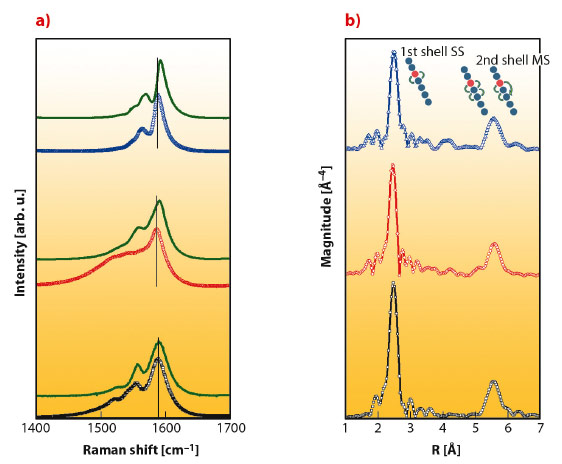- Home
- Users & Science
- Scientific Documentation
- ESRF Highlights
- ESRF Highlights 2012
- Electronic structure and magnetism
- Confinement effect controls the hole doping of carbon nanotubes
Confinement effect controls the hole doping of carbon nanotubes
Single-walled carbon nanotubes (SWCNT) represent ideal nano-confinement systems owing to their one dimensional hollow core with diameters varying between 0.7 and 2 nm and up to a few millimetres in length. The insertion of foreign species into these 1-D nano-cavities leads to novel hybrid system with new and original physical properties.
Inserting iodine into the nanotubes leads to formation of atomic wires i.e. linear chains of iodine atoms. The number of chains inside the nanotube is dependent on the nanotube diameter [1]. As iodine is a typical p-dopant, charge transfer occurs from the nanotube to the iodine, leading to a hole doping of the tubes [2]. Transport properties of nanotubes can thus be modified. Moreover, iodine wires are fragmented in several units of polyiodides lñ. The hole doping of the tube is therefore closely linked to the wire fragmentation.
By means of X-ray absorption spectroscopy (XAS) we have studied the local atomic arrangement of the iodine in hybrid iodine@SWCNT of various diameters. Complementary to this, we studied the dependence of the hole doping with the diameter of the tubes using Raman spectroscopy.
The XAS experiments were carried out at iodine K-edge (32169 eV) on the BM29 beamline. Selected nanotube samples exhibit average diameter around 0.9, 1.1 and 1.42 nm. Synthesis of hybrid iodine@SWCNT was done by mixing nanotubes powders with molten iodine as described elsewhere [3].
 |
|
Fig. 106: a) Comparison of Raman spectra before and after doping (green solid line). b) EXAFS Fourier Transform and sketch of the scattering paths Single Scattering (SS) and Multiple Scattering (MS). From bottom to top, nanotubes of average diameter 0.9 nm (black), 1.1 nm (red) and 1.4 nm (blue). |
Figure 106a displays the tangential modes (G-band, around 1600 cm-1) of the Raman spectra of the nanotube samples. Both positions and profiles of the G-band are particularly sensitive to environmental effects and/or charge transfer, enabling the interactions between nanotubes and host polyiodides to be probed. A significant upshift of 2 cm-1 upon iodine insertion is observed for the large diameter tubes (1.1 nm and 1.4 nm), consistent with the charge transfer between the nanotubes and the polyiodides. By contrast, no shift is shown for the small diameter tube (0.9 nm), suggesting a much weaker charge transfer in the latter case.
R-space (Figure 106b) XAS spectra are very similar for the three samples. All spectra are dominated by the iodine-iodine first coordination shell while a significant contribution is also observed around 5.6 Å. This second shell peak is governed by the multiple scattering paths of the photoelectron (Figure 106). As its amplitude is extremely sensitive to disorder, the presence of this peak reflects the nearly perfect 1D structure of the chains in the system. Average long range 1D ordering was also evidenced thanks to complementary X-ray and electron diffraction experiments.
Analysis of XAS spectra was performed using the Landweber iterations method adapted for EXAFS defined in [4]. By analysing the variation of the structural parameters (bond lengths and coordination numbers), we showed that average lengths of the lñ vary with confinement. In thin nanotubes where confinement effect is strong, lñ are long ( 1) and the doping of the tubes is by consequence weak. In larger nanotubes, lñ are shorter, more charges are thus transferred from the tubes, increasing the hole doping.
1) and the doping of the tubes is by consequence weak. In larger nanotubes, lñ are shorter, more charges are thus transferred from the tubes, increasing the hole doping.
In conclusion, X-ray spectroscopy experiments allow the dependence of the length and charge of the confined polyanions with the tube diameter to be assessed. A critical diameter ΦC around 1 nm was identified. Below ΦC, long polyanions with subsequent weak charge transfer are obtained. For diameters above ΦC, significant shortening of the polyanions leads to a more important charge transfer.
We have shown that confinement effect plays a crucial role in the charge transfer between the confined polyiodide species and the host nanotube.
Principal publication and authors
M. Chorro (a), G. Kane (b, c), L. Alvarez (b,c), J. Cambedouzou (d), E. Paineau (d), A. Rossberg (e), M. Kociak (d), R. Aznar (b,c), S. Pascarelli (a), P. Launois (d) and J.L. Bantignies (b, c), Carbon 52, 100-108 (2013).
(a) ESRF
(b) Laboratoire Charles Coulomb UMR 5221, Université Montpellier 2 (France)
(c) Laboratoire Charles Coulomb, UMR 5221, CNRS, Montpellier (France)
(d) Laboratoire de Physique des Solides, UMR CNRS 8502, Université Paris Sud 11, Orsay (France)
(e) Helmholtz-Zentrum Dresden-Rossendorf, Institute of Radiochemistry, Dresden (Germany)
References
[1] L. Guan, et al., Nanoletters 7, 1532-5 (2007).
[2] L. Grigorian et al., Phys. Rev. Lett. 80, 5560-3 (1998).
[3] T. Michel, et al., Phys. Rev. B 73, 195419-5 (2006).
[4] A. Rossberg, et al., Jour. of Synch. Rad. 17, 280-8 (2010).



